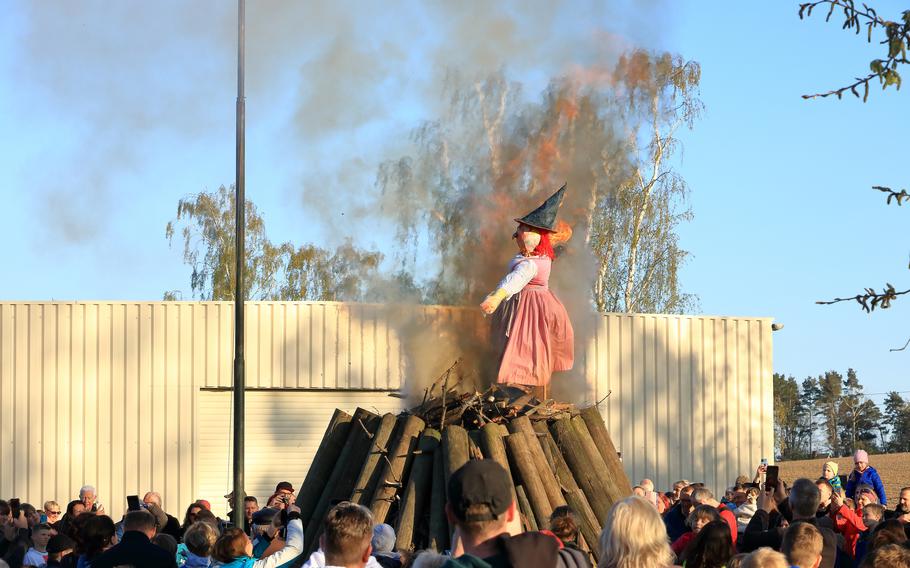
Walpurgis Night is celebrated in various parts of Germany with fire, celebrations and effigy-burning. (iStock)
May 1, a public holiday in several countries throughout Europe, is many things at once. To some, it’s Labor Day, a time to look back on hard-fought worker’s rights by participating in demonstrations or activities organized by unions. For others, it’s the unofficial start of the summer season, a time when leisure facilities from amusement parks to river cruise lines shake off their winter sleep to welcome day-trippers once more. Still others welcome not so much the day itself but its eve, a chance to indulge in partying, often steeped in eerie, unsettling legends.
In Germany, the last night of April is celebrated as Walpurgis Night, a name it takes from an 8th-century abbess revered in her time for her ability to offer protection from not only maladies such as plague, rabies and whooping cough, but also witchcraft.
Centuries ago, when a fear of witches and sorcery ran deep, April 30 was a dreaded date. It was believed that on this day, witches from near and far would gather atop Brocken, the highest peak in the Harz mountain range of central Germany. Arriving atop this mountain in true witch style, by flying in on their broomsticks, the witches would dance, consort with the devil and plan their acts of evil for the coming year.
The local residents would do all they could to protect themselves from the witches passing by on this night. Huge bonfires were set alight, effigies burnt, and loud banging noises created to keep witches at bay.
Communities all across the Harz mountain range cling to their legends associated with Walpurgis Night, and nowadays, around 20 towns host witch-themed markets, parties and dances. Bad Grund, Braunlage, Hahnenklee, Sankt Andreasberg and Schierke are amongst the towns offering programs of interest to tourists. One of the biggest celebrations takes place in the town of Thale. From April 30-May 4, visitors can experience a medieval market and stages offering live music, dance shows and other entertainment. Entry is free. Online: tinyurl.com/dur5ebnz
In other parts of Germany, locals take part in a form of seasonal celebration that likely grew out of the Walpurgis tradition. The tradition is known as Tanz in den Mai, or Dancing into May. On the night of April 30, in venues from fields to soccer pitches, parks to public squares, young and old alike will meet up with friends, listen to music, dance and toast the welcome arrival of the warm months of the year.
Walpurgis Night celebrations are not confined to Germany. In the Czech Republic, April 30 is known as Čarodějnice or Pálení čarodějnic, the Burning of the Witches. Celebrations typically begin with family-friendly activities set in a park or square, followed by the lighting of a bonfire. The grilling of sausages is also standard procedure. In Sweden, the date is known as Valborg, a community celebration to welcome the season of warmth and light. Here, choral singing around the bonfire is likely to be heard. In Finland, the day is celebrated as Vappu. In Helsinki, the crowds gather around Havis Amanda, a fountain featuring a statue of a mermaid as she emerges from the sea, on Market Square. Students in harnesses suspended from a crane crown the art nouveau bronze with her very own oversize version of the white cap typically worn by the year’s crop of graduates.
In Scotland, Ireland and the Isle of Man, a festival with striking similarities to Walpurgis was also held. The rite, known as Beltane, traces back to an Iron Age Celtic belief that the year consisted of two main seasons. Winter and the beginning of the year fell on November 1; midyear and summer fell on May 1. These two junctures were considered a time of vulnerability, when the boundaries between the human and supernatural worlds were temporarily erased.
Beltane welcomed the return of fertility to the land. Before the livestock would be sent out to their summer pastures, they would be driven between two lit bonfires, a ritual thought to cleanse them of disease and ensure the health of the herd.
Although celebrations of Beltane gradually died out, the past few decades have seen a revival of its spirit and many of the traditions associated with it. The Beltane Fire Society of Edinburgh, Scotland, is a volunteer organization that tasks itself with organizing a modern take on the proceedings. In its interpretation of Beltane, set for April 30, more than 300 collaborators taking on the roles of ancient characters and hybrid new ones will be joined by thousands of ticket-holding revelers atop Calton Hill. A procession driven by the steady beating of drums sets off from the National Monument, at its head the May Queen and the Green Man. Following a dramatic stage performance, the lighting of a huge bonfire signals the onset of the summer season. Online: beltane.org